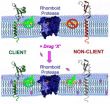(Press-News.org) Researchers have discovered that three commonly used nonsteroidal anti-inflammatory drugs, or NSAIDs, alter the activity of enzymes within cell membranes. Their finding suggests that, if taken at higher-than-approved doses and/or for long periods of time, these prescription-level NSAIDs and other drugs that affect the membrane may produce wide-ranging and unwanted side effects.
More positively, the researchers say, their work provides the basis for a test that drug developers can use to predict and perhaps avoid these side effects in new medicines they make. A summary of the results will be published online in the journal Cell Reports on Aug. 21.
"When drug designers think about possible sources of side effects, they tend to think about which proteins are similar to the protein they are targeting, and they make sure that the former are not affected by the drug," says Sinisa Urban, Ph.D., an associate professor of molecular biology and genetics at the Johns Hopkins University School of Medicine and a Howard Hughes Medical Institute investigator. "But our group has found that drugs that affect the cell membrane can alter the activity of proteins that are totally unrelated to the target."
Working with Syed Moin, then a postdoctoral fellow in his laboratory, Urban's project began as an investigation into the role of the cell membrane in the activity of a group of "cellular scissors" embedded within it, known as rhomboid proteases. When rhomboid proteases cut proteins, the split proteins are released from the membrane. From there, half a protein might go on to signal to another cell or both halves might end up being degraded to prevent further functioning. It all depends on the jobs of the specific proteins that are cut, which are known to play roles in everything from malaria to Parkinson's disease.
Urban says they had already learned that rhomboid proteases have an unusual way of "deciding" which proteins to cut: They look for those whose structures are unstable. Since some proteins are inherently more stable or less stable, rhomboid proteases have certain "protein clients" that are more or less likely to be cut.
Building on the fact that cell membranes provide some support to proteins embedded in them, Urban tried changing the physical properties of this "habitat" to see if alterations would change which proteins rhomboid proteases cut.
He did that by treating human cells with two chemicals that either made the membranes more flexible or distorted their shape. As suspected, rhomboid proteases started cutting proteins they don't normally cut, namely amyloid-beta precursor protein (APP) and the signaling protein Delta, while continuing to cut their standard "clients." This suggests that the enzymes had lost their ability to discriminate between clients and nonclients, or that nonclients started acting like clients when the cell membrane changed, Urban says.
Aware that many drugs end up in the cell membrane, Urban assessed the effect of certain drugs on rhomboid proteases' ability to recognize their normal clients.
Recent studies have looked at the ability of certain prescription-only NSAIDs to repair the function of gamma-secretase, another membrane enzyme that has more than 100 different protein clients, the most famous of which is APP. When gamma-secretase cuts APP at the "wrong" site, it generates a short protein piece that clumps in the brain and goes on to cause Alzheimer's disease.
According to those same studies, some prescription-level NSAIDs, like flurbiprofen, approved for treating serious arthritis, make gamma-secretase less likely to cut APP at the wrong site, but how they do so is unclear.
If the drugs alter gamma-secretase activity by changing its habitat, the researchers thought they might have a similar effect on rhomboid proteases. So Urban treated the cells with flurbiprofen, indomethacin and sulindac at high but similar concentrations to those found in the blood of patients taking them at approved doses. Rhomboid proteases again cut clients they shouldn't, like APP and Delta, just as they had when treated with the membrane-altering chemicals.
When cells were treated with NSAIDS sold over-the-counter, like aspirin, ibuprofen and naproxen, however, the range of clients cut by rhomboid proteases increased only slightly, if at all.
To test the effect of the NSAIDs on cell membranes directly, Urban used an instrument that measures melting temperatures. Because membranes are composed primarily of fat molecules, heat can make them more fluid, like melting butter. In the same way that olive oil is a liquid at room temperature but shortening is a solid, the composition of molecules in the cell membrane can raise or lower the temperature at which it "melts." A lower melting temperature means a more flexible membrane, and the researchers found that the same prescription-level NSAIDs that lowered the membrane's melting temperature caused rhomboid proteases to cut nonclient proteins.
"It's possible that some of the side effects of NSAIDs are caused by their effect on the membrane and its enzymes," says Urban. "Our results are also a caution to drug developers trying to target new drugs to the membrane or hoping to increase the duration or dosage of already approved drugs. Throwing off the balance of the membrane has consequences."
One of the benefits of this study is that the researchers' method can be used to test new drugs for membrane-altering effects. "Now we can use rhomboid proteases as predictors of a drug's possible effects on the membrane and its enzymes," says Urban.
INFORMATION:
This work was supported by grants from the Howard Hughes Medical Institute, the David and Lucile Packard Foundation, and the National Institute of Allergy and Infectious Diseases (AI066025).
On the Web
Link to article (live after embargo lifts): http://dx.doi.org/10.1016/j.celrep.2014.07.039
Urban Lab: http://www.mbg.jhmi.edu/Pages/people/profile.aspx?PID=193
Some anti-inflammatory drugs affect more than their targets
Discovery of changes to cell membranes has wide repercussions for drug developers
2014-08-21
ELSE PRESS RELEASES FROM THIS DATE:
Children with autism have extra synapses in brain
2014-08-21
NEW YORK, NY (August 21, 2014) — Children and adolescents with autism have a surplus of synapses in the brain, and this excess is due to a slowdown in a normal brain "pruning" process during development, according to a study by neuroscientists at Columbia University Medical Center (CUMC). Because synapses are the points where neurons connect and communicate with each other, the excessive synapses may have profound effects on how the brain functions. The study was published in the August 21 online issue of the journal Neuron.
A drug that restores normal synaptic pruning ...
Research explains how cellular guardians of the intestine develop
2014-08-21
Even the most careful chosen meal can contain surprises. To defend against infectious microbes, viruses or other potential hazards that find their way to the intestines, a dedicated contingent of immune cells keeps watch within the thin layer of tissue that divides the contents of the gut from the body itself.
New research at Rockefeller University sheds light on the development of a unique class of immune cells known as intraepithelial lymphocytes (IELs) that reside in this critical interface. The findings, published August 21 in Immunity, may help lead to new insights ...
Alternate mechanism of species formation picks up support, thanks to a South American ant
2014-08-21
A newly-discovered species of ant supports a controversial theory of species formation. The ant, only found in a single patch of eucalyptus trees on the São Paulo State University campus in Brazil, branched off from its original species while living in the same colony, something thought rare in current models of evolutionary development.
“Most new species come about in geographic isolation,” said Christian Rabeling, assistant professor of biology at the University of Rochester. “We now have evidence that speciation can take place within a single colony.”
The findings ...
Mouse model for epilepsy, Alzheimer's gives window into the working brain
2014-08-21
(SALT LAKE CITY)—University of Utah scientists have developed a genetically engineered line of mice that is expected to open the door to new research on epilepsy, Alzheimer's and other diseases.
The mice carry a protein marker, which changes in degree of fluorescence in response to different calcium levels. This will allow many cell types, including cells called astrocytes and microglia, to be studied in a new way.
"This is opening up the possibility to decipher how the brain works," said Petr Tvrdik, Ph.D., a research fellow in human genetics and a senior author ...
Hacking Gmail with 92 percent success
2014-08-21
RIVERSIDE, Calif. — A team of researchers, including an assistant professor at the University of California, Riverside Bourns College of Engineering, have identified a weakness believed to exist in Android, Windows and iOS mobile operating systems that could be used to obtain personal information from unsuspecting users. They demonstrated the hack in an Android phone.
The researchers tested the method and found it was successful between 82 percent and 92 percent of the time on six of the seven popular apps they tested. Among the apps they easily hacked were Gmail, CHASE ...
Researchers identify potential risk factors for urinary tract infections in young girls
2014-08-21
Winston-Salem, N.C. – August, 21, 2014 – Young girls with an intense, red, itchy rash on their outer genital organs may be at increased risk of developing urinary tract infections (UTIs), according to new research from Wake Forest Baptist Medical Center. The treatment may be as simple as better hygiene and avoiding potential irritants such as bubble baths and swimming pools.
"Vulvitis is a common condition affecting women and girls of all ages," said senior author Steve J. Hodges, M.D., associate professor of urology at Wake Forest Baptist. "We found that girls with ...
Difficulty assessing effort drives motivation deficits in schizophrenia, study finds
2014-08-21
SAN FRANCISCO, Aug. 21, 2014 – Individuals with schizophrenia often have trouble engaging in daily tasks or setting goals for themselves, and a new study from San Francisco State University suggests the reason might be their difficulty in assessing the amount of effort required to complete tasks.
The research, detailed in an article published this week in the Journal of Abnormal Psychology, can assist health professionals in countering motivation deficits among patients with schizophrenia and help those patients function normally by breaking up larger, complex tasks into ...
A NASA satellite double-take at Hurricane Lowell
2014-08-21
Lowell is now a large hurricane in the Eastern Pacific and NASA's Aqua and Terra satellites double-teamed it to provide infrared and radar data to scientists. Lowell strengthened into a hurricane during the morning hours of August 21.
When NASA's Aqua satellite passed over Lowell on August 20 at 21:05 UTC (4:05 p.m. EDT), the Atmospheric Infrared Sounder got an infrared look at Lowell's cloud top temperatures when it was still a tropical storm. AIRS showed a very thick band of thunderstorms surrounding the center of circulation and what appeared to be a very small cloud-free ...
Researchers examine impact of race and ethnicity in motor complete spinal cord injury
2014-08-21
West Orange, NJ. August 21, 2014. Researchers have published a study examining racial and ethnic influences in the outcomes of patients with motor complete spinal cord injury (SCI). The article, "Racial and ethnic disparities in functioning at discharge and follow-up among patients with motor complete SCI," was published online ahead of print on August 2 by the Archives of Physical Medicine & Rehabilitation (doi: 10.1016/j.apmr.2014.07.398). Findings included small but significant differences in self-care and mobility at discharge; no differences were apparent at 1-year ...
Reading 'Fifty Shades' linked to unhealthy behaviors
2014-08-21
EAST LANSING, Mich. --- Young adult women who read "Fifty Shades of Grey" are more likely than nonreaders to exhibit signs of eating disorders and have a verbally abusive partner, finds a new study led by a Michigan State University researcher.
Further, women who read all three books in the blockbuster "Fifty Shades" erotic romance series are at increased risk of engaging in binge drinking and having multiple sex partners.
All are known risks associated with being in an abusive relationship, much like the lead character, Anastasia, is in "Fifty Shades," said Amy Bonomi, ...
LAST 30 PRESS RELEASES:
University of Oklahoma researcher awarded funding to pursue AI-powered material design
Exploring how the visual system recovers following injury
Support for parents with infants at pediatric check-ups leads to better reading and math skills in elementary school
Kids’ behavioral health is a growing share of family health costs
Day & night: Cancer disrupts the brain’s natural rhythm
COVID-19 vaccination significantly reduces risk to pregnant women and baby
The role of vaccination in maternal and perinatal outcomes associated with COVID-19 in pregnancy
Mayo Clinic smartwatch system helps parents shorten and defuse children's severe tantrums early
Behavioral health spending spikes to 40% of all children’s health expenditures, nearly doubling in a decade
Digital cognitive behavioral treatment for generalized anxiety disorder
Expenditures for pediatric behavioral health care over time and estimated family financial burden
Air conditioning in nursing homes and mortality during extreme heat
The Alps to lose a record number of glaciers in the next decade
What makes a good proton conductor?
New science reporting guide published for journalists in Bulgaria
New international study reveals major survival gaps among children with cancer
New science reporting guide published for journalists in Turkey
Scientists develop a smarter mRNA therapy that knows which cells to target
Neuroanatomy-informed brain–machine hybrid intelligence for robust acoustic target detection
Eight SwRI hydrogen projects funded by ENERGYWERX
The Lundquist Institute and its start-up company Vitalex Biosciences Announces Strategic Advancement of Second-Generation fungal Vaccine VXV-01 through Phase 1 Trials under $40 Million Competitive Con
Fine particles in pollution are associated with early signs of autoimmune disease
Review article | Towards a Global Ground-Based Earth Observatory (GGBEO): Leveraging existing systems and networks
Penn and UMich create world’s smallest programmable, autonomous robots
Cleveland researchers launch first major study to address ‘hidden performance killer’ in athletes
To connect across politics, try saying what you oppose
Modulating key interaction prevents virus from entering cells
Project explores barriers to NHS career progression facing international medical graduates
Jeonbuk National University researchers explore the impact of different seasonings on the flavor perception of Doenjang soup
Two Keck Medicine of USC Hospitals named Leapfrog Top Teaching Hospitals
[Press-News.org] Some anti-inflammatory drugs affect more than their targetsDiscovery of changes to cell membranes has wide repercussions for drug developers






